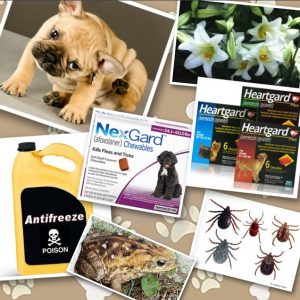
Everything You Wanted To Know About Chocolate Toxicity In Pets
Hi Everyone! I am so excited for Halloween. Our neighborhood goes all out and Rob, Luke, Dory and I have our whole family over for eating, drinking, and handing out candy. Every year we all (parents, kids, grandparents, aunts, uncles, friends) try and get correlating costumes. Last year we were all Muppets and this year we are all going to be Sesame Street characters! Our neighborhood is filled with hundreds of kids walking around, parties at all the homes, and the most adorable pups walking around in cute costumes. So, as you can imagine, this holiday brings many pets to my animal hospital for chocolate toxicity. Although most pet owners are aware that chocolate is toxic for pets, many people do not. It is common to hear that friends or family members gave their pet some chocolate, or more commonly, they got into the candy bowl. With Halloween tomorrow, I wanted to discuss what chocolate toxicity is, what to do if your pet digests chocolate, and ways to keep your pet safe during the holiday.
What is chocolate toxicity?
Chocolate contains two ingredients that are toxic in large quantities: theobromide and caffeine. Different types of chocolate contain different amounts of theobromide and caffeine; therefore, the amount and the type of chocolate your pet eats play a role in its toxic effects.
How much chocolate does my dog need to consume to reach toxic levels?
Toxic doses of theobromine (the active ingredient in chocolate that is toxic) are 9 mg per pound of dog for mild signs, and up to 18 mg per pound of dog for severe signs. Milk chocolate contains 44 mg per ounce of theobromine while semisweet chocolate contains 150 mg per ounce. Baking chocolate contains the most at 390 mg per ounce.
What are the clinical signs?
Signs your pet may have an adverse reaction to chocolate include:
- Diarrhea/vomiting from the high-fat content in the chocolate
- Restlessness
- Hyperactivity
- Muscle twitching, tremors
- Increased drinking and urination
- Excessive panting
- Irritability
- Increased heart rate and abnormal heart rhythm
In extreme situations, seizures, collapse, and even death can occur.
What is the treatment?
Unfortunately, there is no specific antidote for pets that have ingested chocolate. If your dog or cat has ingested chocolate, you should contact your veterinarian immediately. Many times we can assess on the phone how much they ingested, and assure you it is not enough to cause a toxicity. However, if your pup did ingest chocolate, we can initiate treatment immediately by inducing vomiting, administering IV fluids, and monitoring during hospitalization.
The good news is that most pets treated for chocolate toxicity recover and return to normal within 24–48 hours of treatment.
What can I do to keep my pet safe?
The best way to avoid any potential chocolate ingestion is to keep your pet in a safe isolated place during Halloween (at home). I know people love to walk around and trick or treat with their dogs and it is difficult to resist showing off your cute lil pup dressed in spaghetti and meatballs. If you do decide to bring along your pet for the festivities, make sure to keep a very close eye on them at all times, and look out for dropped candy on the ground.
Once your kids (or you) get home from trick or treating, make sure to immediately place the candy basket up high and away from the reach of your pet. Pick a great spot. If your pup is anything like mine, they will move mountains to get to food.
I hope everyone has a fun, great and safe Halloween! As always, keeping pets safe is always my top priority. I hope this article helps to avoid potential emergencies. Happy Halloween everyone!





